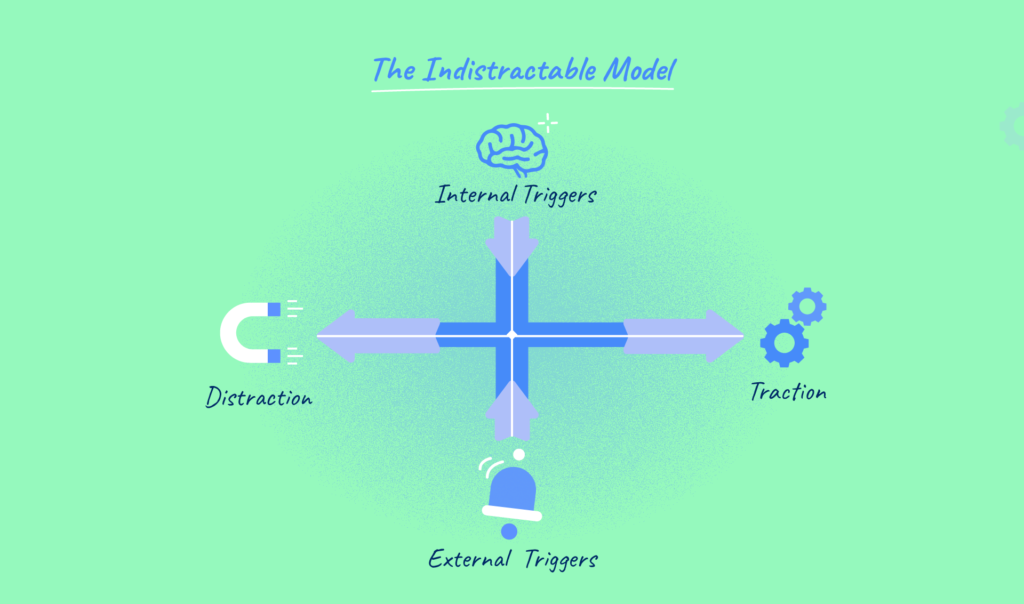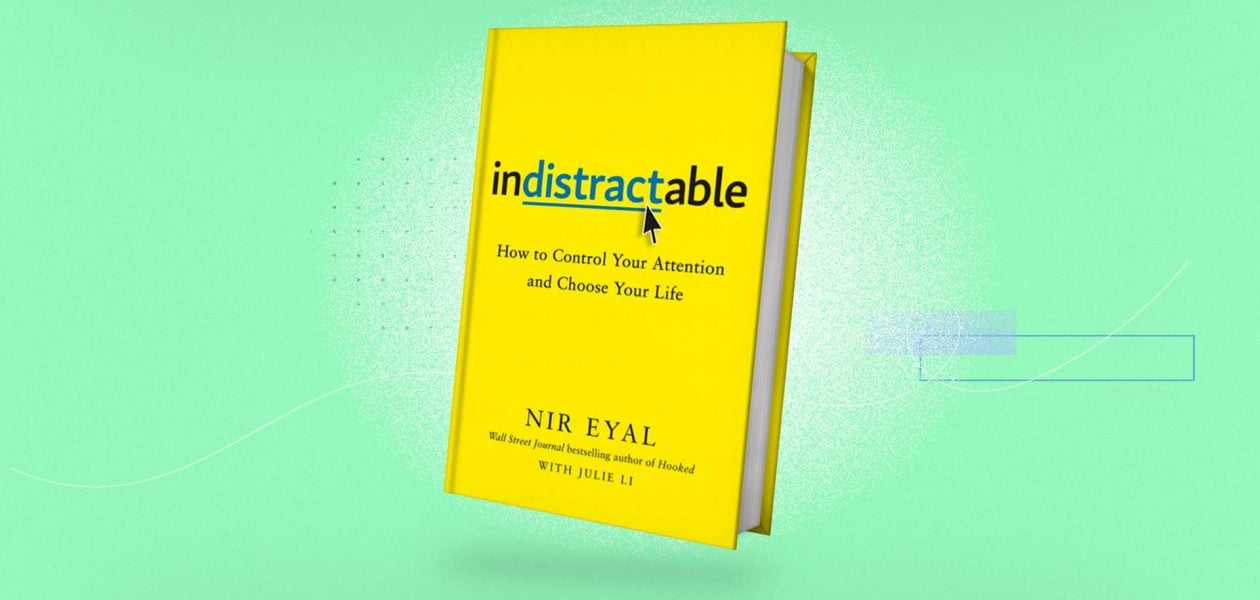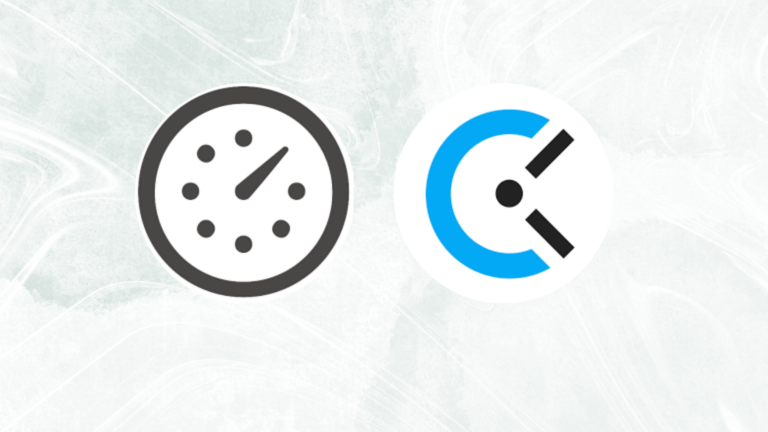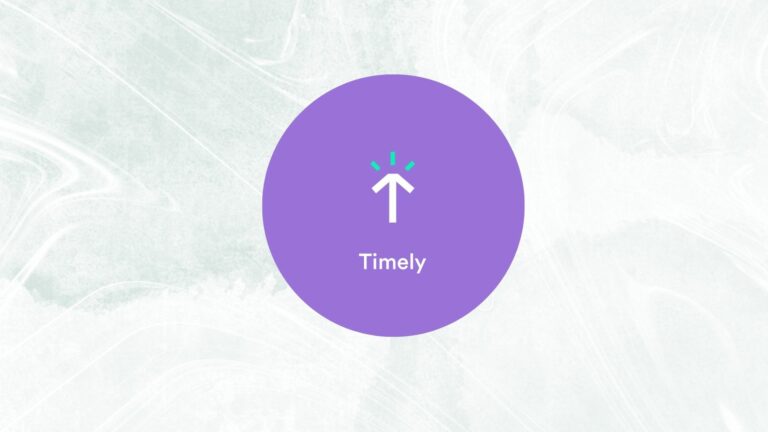The classic hallmark of growing up in a conventional brown family is having your phone blamed for all of your shortcomings. Got bad grades in an exam? Blame your phone. You seem moody and sad? Blame your phone. You’re really sick? Also, blame your phone. And while convincing my technologically inept parents that my phone probably has nothing to do with my food poisoning and that it’s probably the fifth plate of sushi I had 2 days ago, I too have often blamed my phone for making me distracted from the things at hand. How right am I to do that? With Indistratctable, Nir Eyal makes a case for the blamelessness of technology in relation to distraction and how to be indistractable.
More than 5 years before the release of this book Nir Eyal had published Hooked: How to Build Habit-Forming Products, a Wall Street Journal bestseller and a bible of sorts for designers. The book dissects the psychology of how tech companies manipulate users and make irresistible and intentionally habit-forming products. According to Nir, this is what makes him a great person to tell you how to fight distractions. He knows how these products are built, what makes them powerful, and how you can beat them. His argument in this book is also made much more important in part because it carries significance for wider conversations about the ethics of persuasive design.
It would be a grave mistake to dismiss Indistractable as a half-assed confession from a repentant tech-insider. Or even an attempt to backtrack for that matter. In fact, Indistractable is void of any regret or re-examination whatsoever, and as another review I read on this book states “Eyal deserves some credit for this.”
The genesis of this book comes from something that happened to Nir Eyal a few years ago. While he was in the middle of spending some quality father-daughter time, his daughter asked him a question but he ended up getting distracted by something on his phone. By the time he looked up his daughter was gone as well as a chance to bond. He found this was a common phenomenon in his relationships and over the next few weeks started implementing a hardcore digital detox and swore off any form of technology. But he soon realized this wasn’t enough. As he puts it in the book,
“I discovered that living the life we want requires not only doing the right things; it also requires we stop doing the wrong things that take us off track.”
He starts off by making a divide between distraction and the opposite traction. Distraction is anything that pulls you away from what you want to do and traction is anything that pulls you towards what you want to do. He argues that humans are built to be distracted and that distractions will always exist; managing them is our responsibility.

In Part One: Master Internal Triggers, you’ll learn about triggers, the different types of triggers, what they can lead to, and how to harness them for your benefit. Distraction is about escaping something uncomfortable such as a rumbling stomach or marital problems or deep dissatisfaction with your career. As Nir puts it, “Even when we think we’re seeking pleasure, we’re actually driven by the desire to free ourselves from the pain of wanting.” That is why you can’t blame tech for your distraction. Tech is only a proximate cause. We blame it for our inability to get things done and fail to look at the true underlying problem. He suggests writing down your feelings and what triggered them the next time you find yourself getting distracted. Another tip he suggests is to make tasks more fun by rewarding yourself at the end. This is the idea behind the famous Pomodoro technique. Lastly, he suggests you give yourself a pep talk to boost your confidence.
In Part Two: Make Time for Traction, Nir looks at the importance of making time for the things you really want to do. If you don’t know what you’re striving towards, it’s impossible to tell what distraction is actually preventing you from achieving. That is why it’s so important for you to have a plan. And what is key to effective planning? Timeboxing, or setting aside specific “slots” in your weekly schedule for the completion of particular tasks. You’ll learn to plan your time with intention, even if you choose to spend it scrolling through your Instagram feed looking for fashion inspiration.
Part Three: Hack Back External Triggers follows a no-holds-barred examination of the unwanted external triggers and how to manage the multitude of external triggers in the world around you. This part is packed with tips on dealing with distractions at work like emails (what he calls the biggest source of distraction in this day and age), pointless meetings, and notifications on your phone.
Part Four: Prevent Distraction with Pacts holds the last key to making you indistractable. If you want to stay indistractable, you’ll have to fight every day. That is not as daunting as it might sound – in fact, there are plenty of tricks to help you do just that. One such pact is the effort pact which makes your access to unwanted behavior more difficult. Another is the price pact. As you might have guessed from the name, this imposes fines for missing targets. The author, for example, decided he’d burn a $100 bill every time he missed a gym session. In the three years since he first made that crazy-sounding pact with himself, he hasn’t had to give a single dollar!
Parts 5 through to 7 offer practical advice on how to make your workplace less distractible, how to raise indistractable children, and how to build indistractable relationships.
My take:
The book was definitely very easy to digest, quick to read, and full of memorable stories but most importantly it truly made me question why we live our lives the way do when we can easily live more fulfilling lives. Why have we crammed our lives with so many meaningless contacts with technology and virtual people that we have to force ourselves to make time to just sit and think, or to chat with other real people, or to just not reply to some dopamine-inducing ping on our phones? The part where Nir Eyal dives into the psychology and root cause behind our distractions was the highlight of the book.
My most favorite part was where he mentioned that books or typewriters were just as distracting as the internet when they first came about. This made me realize that smartphones and the internet are this century’s scapegoat for blaming its distractions on. Rather, the internet (and the modern-day connectivity we enjoy thanks to it) can be both a friend or a foe depending on how we use it. It is on us to effectively master its endless prowess.
That said, it also gave out so many good ideas- timeboxing your schedule (in order to, for example, reserve time to respond to emails rather than responding as they come in), using certain apps to help achieve goals, the ACT theory, habit setting, and making your tasks more fun by introducing a reward system like binge eating a whole bucket of ice-cream.
I also appreciated the last 3 parts that dictate how to integrate the concept of being indistractable in your workplace, relationships, and when raising your children. This is something that is often missing from self-help books and made me realize how being indistractable is a joint effort.
This book is tailor-made for anyone who has the tendency to succumb to procrastination and distraction, self-starters looking to foster better habits, and parents concerned about their children’s relationship with technology.
I have to admit like many self-help books, it could have been condensed down to a much shorter version and make the same points- a task this book accomplishes on its own with the Remember This section at the end of each chapter. This section is a personal favorite as it helped me gain clarity.
Finally, the biggest plus point for me would definitely be the numerous stories from Greek mythology. If you were to ever recommend a history buff a self-help book this would be it.
The book was an eye-opener and one of a kind. It was like a treasure trove of good ideas, each more precious than the other.


